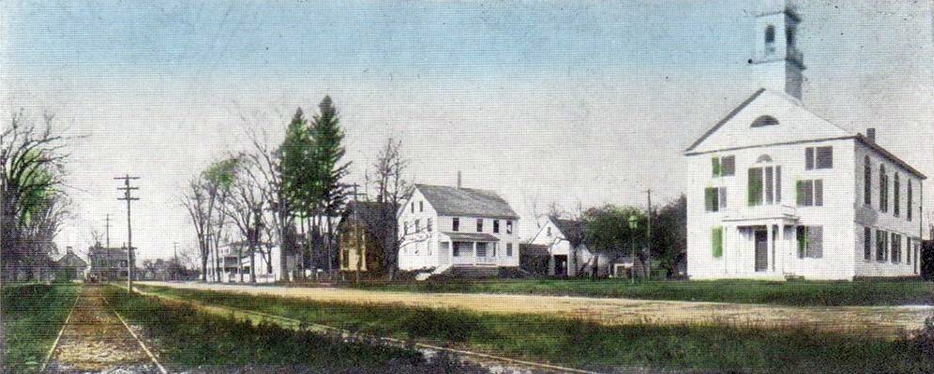HAMPTON: A CENTURY OF TOWN AND BEACH, 1888-1988
Chapter 22 — Part 1
Back to previous chapter — Forward to next section — Return to Table of Contents

[Photograph courtesy David F. Colt Jr., and was not in original Randall book.]
The first legal meeting of the First Baptist Church of Hampton was held on July 17, 1817, following its incorporation earlier that year. Originally called the First Baptist Society, incorporators bear names familiar to Hampton residents: John Dearborn, Philip Towle, Abraham Marston, Amos Towle, Jr., Joshua Lane, Joseph Mace, Abner Mace, Samuel Brown, Samuel Nudd, Willard Emery, and James Tuxbury. Joshua Lane was elected the first clerk of the society. On October 16, 1819, twenty-four persons meeting at the home of Joshua Lane subscribed to a constitution and became the first church members. It is interesting to note that persons who were members of the society were not necessarily members of the church. The two groups existed and functioned side by side. The First Baptist Society handled financial affairs and the First Baptist Church concerned itself with the specific ministry tasks of the faith, the care of persons, and the calling of pastors. Persons could be members of one or both groups. This two-track system does not exist today.
The present church building site was purchased in 1834. By October of that year, a meetinghouse for worship was erected. The original building measured 40 feet by 48 feet. In 1839 the building was enlarged and a tower added. In 1852 the land for the parsonage was purchased, and two years later a two-story dwelling and a stable were erected. The Reverend William Rogers, his wife, and nine daughters were the first to occupy the parsonage.
One of the most distinguished pastors of the early era of the church was the Reverend Dr. DeWitt C. Durgin, whose term of 12 years of service remains the longest of any minister of the church. He served from 1858 through 1870. At one time he was principal of Hampton Academy and represented the town in the New Hampshire Legislature. Later he became president of Hillsdale College in Michigan and was awarded a doctor of divinity degree from Bates College.
The desirability of having a vestry was first discussed in 1867. It was not until 1878 that the dream was fulfilled. In that year it was voted to move the horse sheds to the rear of the lot, move the meetinghouse back 45 feet, raise the building, and erect a vestry beneath it. An extensive remodeling project of $3,100 was undertaken in 1886, including reroofing, replastering, installation of furnaces, a new chimney, removal of old pews, and the installation of more modern ones. The First Baptist Meetinghouse was rededicated on November 11, 1886.
After the turn of the century, another distinguished pastor effected significant growth in the church. The Reverend Frederick H. Buker served from 1916 through 1922. During his years of service, 40 new members were added to the fellowship. The 100th anniversary of the society was celebrated with five days of activities, including a special musical program, a picnic, and special dinners.
Other pastors of note included the Reverend Harley Nelson (1931-33), who was effective with ministry to youth and who led them in several church dramas. Under the Reverend R. W. E. DeWoIf (1937-39), there was a substantial increase in membership. At that time the Loyal Workers, the women’s organization of the church, started an organ fund. The organ was installed and dedicated on September 24, 1940.
In 1962 it was voted that the society be dissolved and view all functions financial as well as pastoral, as ministries of the church. While the First Baptist Church has never had a consistentiy large congregation, its members have maintained a strong witness in the community.
Ministers of First Baptist Church
Through the history of the church there were certain periods when no full-time pastor was in residence. This was due to interim situations or the fact that the church simply relied on the services of transient preachers to conduct Sunday worship. The list below represents those called to serve as pastor since 1889.
| -—Reverend Dr. Peter E. Roussaki |
| Rev. W. A. Tucker Rev. F. Schermerhorn Rev. D. H. Adams Rev. G. 0. Wiggin Rev.S. D.Church Rev. G. G. Waterman Rev. W. Lincoln Phillips Rev. J. L. Smith Rev. Frederick H. Buker Rev. Bernard Christopher Rev. Edward E. Eno Rev. Philip A. Gordon Rev. Harley P. Nelson Rev. Earl W. Douglas Rev. R. W. E.DeWolfe Rev. Lloyd M. Perrigo Rev. Lincoln Atwood Smith Rev. Lee L. Burton Rev. John Watson Rev. Walter Oddy Rev. I. Holland Maughan Rev. Thomas Raisner Rev. Paul Hazlett Rev. John Scruton Rev. David Garland Rev. Dean Kennedy Rev. Andy Magnusson Rev. Dr. Peter E. Roussaki Rev. Donna Hailson Rev. John Pearson Rev. MaryBeth Ellis Rev. Dr. Wilbert Gough Rev. Christopher Underation |
1889—1892 1892—1895 1895—1899 1899—1902 1902—1903 1904—1909 1909—1913 1913—1915 1916—1922 1922—1924 1925—1928 1928—1931 1931—1933 1933—1936 1937—1939 1940—1943 1943—1947 1947—1949 1950—1952 1952—1956 1957—1961 1961—1966 1967—1971 1972—1974 1975—1981 1981—1983 1983—1986 1986—1989 1989—1994 1994—1996 1996—1999 1999—2002 2002— |
|
[Note: Some of the above short-term ministries were those of seminary students serving part time. Upon graduation these students would take full-time positions. The Rev. John Watson was an experienced and excellent minister but during much of his stay he was incapacitated by a heart conditon and he called in Mr. Vaugh Overman to perform most of his duties. Overman was a very popular and effective assistant pastor.
[The last five pastors’ names were not in the original book.] |

From a glass plate found by David F. Colt, Jr. in 1960 in the attic of Lewis and Mary (Toppan) Clark. Photo was probably taken in the 1890’s perhaps before the street car tracks were laid. Ads on pole say Magic Yeast and The Irwin, My Cigar. [Photograph courtesy David F. Colt Jr., and was not in original Randall book.]